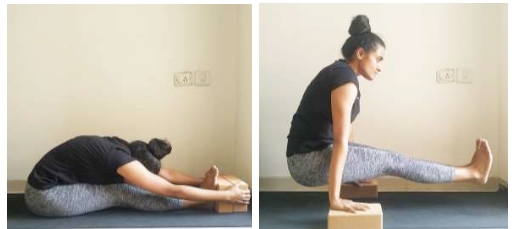Yoga Props And Their Benefits on Our Practice
by Sohaila Akbar
Friends, do you take the support of props in your personal yoga practice? Have you ever used them, maybe in a yoga shala or studio, or even at home? And if you have used them before, what do you think of them? Do you think they are essential to your practice? Or just a good addition? Or do you think they should be done away with? Well, almost all yoga schools and yoga studios almost always have a stack of various props ready for use. Today, we are penning down some thoughts on the use of props. And I don’t mean only the props available commercially (blocks, belt, wheels, etc.) but also commonplace alternatives like blankets, bolsters, towels, scarves, walls and chairs. Well, even the yoga mats we use are essentially props that prevent us from slipping on the floor!

Most practitioners feel that props can help us physically and mentally explore asanas that we are not able to get into yet, can help us derive benefits from asanas which we would not have been able to do otherwise (can be due to various reasons), can help us get better rest while in relaxing postures, and can even support our practice after certain injuries.
Let us look at these benefits in a little more detail.
Proper alignment
Often, we struggle to get into a pose (or our idealistic version of what the pose should look like) due to certain body limitations like lack of flexibility, low body strength, etc. So, in order to achieve the asana ‘visually’, we adjust our bodies accordingly. For example, moving the torso out of alignment with the hips in order to place the palm on the mat. If we simply place a block (either vertically or horizontally) under the palm, we can maintain the correct alignment, while experiencing all the stretches in the body as a result of this asana.
Encouragement to try relatively advance postures
Sometimes, we refrain from trying certain postures that require a bit more strength or flexibility than what we currently have. Understandably, strength and flexibility develop over time, but props can give us just that extra support required to at least start getting into that posture. This is very common while practising inversions like Sirsasana or Pincha Mayurasana, where we use the wall as prop to reduce our fear of falling over. Another case in point is Pasasana, which requires a flexible spine and pretty mobile shoulder joints. We can use a belt as a prop here, held in between both the fists to close the gap between them. Over time, we can reduce the distance between the fists by inching them closer towards each other while still holding on to the belt.

Injury prevention
Using props can stop us from overstretching our muscles to get into a posture, thus preventing injuries. For example, if the practitioner’s body is not ready, taking the palms to the floor in Uttanasana can strain the hamstrings and result in a muscle pull or tear. Placing blocks under the palms acts as an extension to the hands, preventing any probable injuries.
Support after an injury
In cases when you are recovering from any physical injury, props can support you by providing a safer environment for your practice. Let’s say, you are recovering from lower back pain. In that case, touching your feet on the ground in Halasana can be difficult or painful. So, you can use a chair as a prop and place your feet on it, reducing the stress on your lower back.
Advancement in the posture
Props can be a great tool to extend yourself a little bit further in certain poses, while helping you develop the required strength in others. For instance, if one is already comfortable in Paschimottanasana, placing a block or two in front of the feet can help lengthen the spine, calves and hamstrings further. In asanas like Brahmacharyasana or Lolasana, which require lifting off the floor while balancing on the hands, placing a block under each palm can help raise the body and develop core strength.
Stability
When we maintain any posture for longer durations, it is not always easy to maintain the stability or alignment. This is especially true for Yin Yoga, where the postures are typically held between 3-5 minutes. For instance, if the hips are not flexible, maintaining the Yin pose Butterfly for 5 minutes can be extremely challenging. Placing one or two blocks under the forehead can help achieve stability in the pose.
Mobility
Props can be extremely helpful in increasing the mobility of joints. There are many movements one can practise using props in order to achieve shoulder, spine and hip mobility, among others. For example, stretching your arms on a yoga wheel while in Shashankasana variation or catching the wheel by taking the hands behind the back in Setubandhasana variation can help greatly in shoulder opening.
Deeper breathing and relaxation
About the Author

Sohaila Akbar
Sohaila is a Yoga teacher, keen on bringing about positive changes in the lives of others through the knowledge that she has received from her teachers. Prior to this she was a school teacher working towards imparting academic, social and ecological knowledge to young learners. Sohaila is an avid reader of books and have an undying love for fiction. She prefers paperbacks and hardcovers over e-books anyday. She loves travelling, and a good cup of coffee is always welcome!


